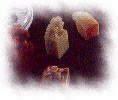Visual Arts -- Chop Engraving
A sentence frequently heard in the everyday life of a Chinese is "Please sign your name and put your chop on it." You need your name chop to withdraw money from the bank, to pick up a registered letter from the post office, to legalize a contract, and to acknowledge receipt of official documents. In China, from ancient times to the present, from official government business to private affairs, no matter how important or trivial, your chop affixes your credit and your promise. After signing your name, your chop is still required for a document to be legally binding. Name chops are also the constant companions of Chinese calligraphers and painters. Artists follow the custom of stamping their works with their name chops to "sign" them and as proof of authenticity. Despite its small size, the chop plays an extremely important role in the life of a Chinese.
Name chops are engraved by hand. Through the technique of carving, name chops utilize the beauty of written Chinese characters. A name chop produces virtually the same image of the same characters or figures no matter how many times it is used, and so can be considered a forerunner of the great Chinese invention of printing Its importance cannot be underestimated.
Tradition
Traditionally, the most common materials for making chops were copper, for the general population, and jade, for the emperor and nobility. Both copper and jade are highly durable materials which must be slowly and carefully cast or ground by an expert craftsman in a very exacting process. However, by the end of the Yuan Dynasty (1279-1368 A.D.), the great painter Wang Mien began to carve his own chops from pyrophylite, a relatively soft mineral. When a skilled calligrapher carves a chop himself, the beauty of the calligraphy shows up and the especially pleasing effect achieved by knife carving, as opposed to casting or grinding, stands out.

|
The most important part of chop carving is the engraving of the stamping surface. And half the task of carving a chop is done once the calligraphic style has been chosen and the arrangement of the characters decided; this is called the "composition" of a chop. Carving the characters with skillful, confident cuts is called "knife technique". The marriage of these two techniques results in a totally new form of written expression referred to as "calligraphic technique." Chop engraving that is of a certain standard or higher displays excellence in the three areas of "composition," "knife technique," and "calligraphic technique."
To further increase the refinement and beauty of the chop design, chop engravers may create an elaborate sculpture on the top of the chop or cut out a scene on the sides in shallow relief. The combination of two and three-dimensional art on a chop gives it special artistic depth and sophistication.

|
Modern Day
Today, the art of chop carving is still highly venerated in the China. Chops constitute an independent category in fine arts exhibitions, and classes in chop art are held in college and university art departments around the country. Many chop engravers vigorously try to promote more interest in this unique Chinese art. Modern engravers employ electronic tools as traditional hand carving to create chops. There are also study sessions led by an instructor, or discussion gatherings held among people involved in chop art.
Chops still have a very practical nature. Commonly seen in chop engraving shops are uncarved chops made of wood, stone, metal alloys, and synthetic fiber that the customer can pick from according to personal preference and need. An even wider selection of calligraphic styles from the traditional seal script to scripts made especially for chop engraving are at the customers disposal. The swelling stream of tourists visiting China has sparked foreign interest in chop art; a unique name chop is a highly personalized and unique souvenir to keep and treasure. This uniqueness assures the continued thriving of this art regardless of geographical boundary or passage of time.



 Chinese Culture
Chinese Culture